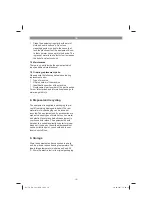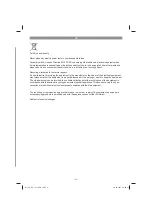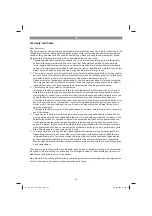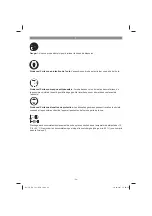
GB
- 18 -
6. Operation
6.1 Charging the Li battery pack (Fig. 5-6)
1. Remove the battery pack (6) from the handle,
pressing the pushlock button (C) downwards
to do so.
2. Check that your mains voltage is the same as
that marked on the rating plate of the battery
charger. Insert the power plug of the charger
(7) into the socket outlet. The green LED will
then begin to blink.
3. Push the battery pack onto the battery char-
ger.
In section 10 (Charger indicator) you will
fi
nd a
table with an explanation of the LED indicator on
the charger.
If the battery pack fails to charge, check for the
following:
•
voltage at the power socket
•
whether there is good contact at the charging
contacts of the charging unit
If the battery pack still fails to charge, send
•
the charger and charging adapter
•
and the battery pack
to our customer service center.
To ensure that the Li battery pack provides
long service you should take care to recharge
it promptly. You must recharge the battery pack
when you notice that the power of the cordless
equipment drops.
6.2 Battery capacity indicator (Fig. 7 /Item d)
Press the button for the battery capacity indicator
(e). The battery capacity indicator (d) shows the
charge status of the battery using 3 LEDs.
All 3 LEDs are lit:
The battery is fully charged.
2 or 1 LED(s) are lit:
The battery has an adequate remaining charge.
1 LED blinks:
The battery is empty, recharge the battery.
All LEDs blink:
The battery pack has undergone exhaustive di-
scharge and is defective. Do not use or charge a
defective battery pack.
6.3 Switching On/O
ff
(Fig. 8/Item 1)
•
To switch on the equipment, move the switch
(1) from “0” to “1”.
•
To switch off the equipment, move the switch
(1) from “1” to “0”.
6.4 Speed controller (Fig. 9/Item 3)
You can select the speed by turning the speed
controller (3).
Plus direction:
Higher speed
Minus direction:
Lower speed
6.5 Working with the eccentric grinder/sander
•
Place the whole surface area of the sanding
disk on the material.
•
Switch on the machine and move it with gent-
le pressure over the workpiece, making circu-
lar or transverse and linear movements.
•
Use a coarse grit for coarse sanding and a
finer grit for finish sanding. You can find the
best grit size for the job by carrying out san-
ding tests.
Caution!
The dusts which are formed while the equipment
is being used may be a health hazard:
•
Always wear safety goggles and a dust mask
during sanding work.
•
All persons who work with the equipment or
enter the workplace must wear a protective
dust mask.
•
Eating, drinking and smoking are prohibited
at the workplace.
•
Paints containing lead are not allowed to be
used!
7. Cleaning, maintenance and
ordering of spare parts
Danger!
Always pull out the mains power plug before star-
ting any cleaning work.
7.1 Cleaning
•
Keep all safety devices, air vents and the
motor housing free of dirt and dust as far as
possible. Wipe the equipment with a clean
cloth or blow it with compressed air at low
pressure.
•
We recommend that you clean the device
immediately each time you have finished
using it.
Anl_TE_RS_18_Li_SPK1.indb 18
Anl_TE_RS_18_Li_SPK1.indb 18
10.01.2017 15:04:11
10.01.2017 15:04:11
















































